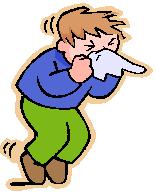 I believe it is not just coincidence that I have made it through this entire 2009 winter without a cold. I don’t typically get sick to begin with (knocking on wood now) and the last time I had a sore throat and stuffed up noise was just after the Christmas holidays. My big goal for this past winter was to run through it, and November and December were months I used to get used to running in the cold. I was outside for 3-4 mile runs three times a week. I had been mentally preparing to start true marathon training after New Years and so my first few runs of 2009 were indeed with a runny nose, but it didn’t last long. I have been sniffle-free this winter while everyone around me has had the flu, the common cold, aches and pains, and I believe I have running to thank for keeping my immune system strong.
I believe it is not just coincidence that I have made it through this entire 2009 winter without a cold. I don’t typically get sick to begin with (knocking on wood now) and the last time I had a sore throat and stuffed up noise was just after the Christmas holidays. My big goal for this past winter was to run through it, and November and December were months I used to get used to running in the cold. I was outside for 3-4 mile runs three times a week. I had been mentally preparing to start true marathon training after New Years and so my first few runs of 2009 were indeed with a runny nose, but it didn’t last long. I have been sniffle-free this winter while everyone around me has had the flu, the common cold, aches and pains, and I believe I have running to thank for keeping my immune system strong.
Running, The New Airborne?
There are many tips, tricks, vitamins, and pseudo-medicines that claim to support the intricate network of cells and organs in our immune system thereby making us less susceptible to colds. I personally do not take a daily vitamin (though I know I should) and there are two containers of Airborne, the popular “health formula,” in my medicine cabinet that haven’t been touched. I am not a doctor or a nutritionist or a trainer, but there are plenty of studies that have been done about how exercise in general, not just running, can strengthen the immune system which supports my theory that running is a great form of preventive cold medicine.
Tip number 7 on WebMD for cold and flu prevention is to do regular aerobic exercise. The benefit of cardiovascular workouts is that it gets your heart rate going which pumps more blood, making you breathe faster, and transfers oxygen from your lungs to your blood. As this happens, you transfer disease-fighting white blood cells from the organs to the bloodstrem. Once you sweat and your body heats up, you have truly engaged the body’s natural virus-killing cells. Just 30 minutes of aerobic exercise a day is enough to jump start your immune system and help fend off colds. So just think what increasing the time you spend exercising or running can do for you.
Running with a cold is another topic entirely and doctors have pretty consistent guidelines runners should follow. An August 2004 article in Runner’s World shares a rule of thumb from marathoner and Ph.D., David Nieman, who suggests that “symptoms below the neck (chest cold, bronchial infection, body ache) require time off, while symptoms above the neck (runny nose, stuffiness, sneezing) don’t pose a risk to runners continuing workouts.” There are a host of other suggestions to consider so that you do not injure yourself more by powering through a cold or the flu, but the most important advice is to listening to your body and know your limits.
While running cannot cure the common cold, it’s nice to know that my running shoes are just as good “preventive medicine” as the bottle of Airborne on the shelf.

Pingback: Running With a Cold | Coughing, Sniffling, Running | Health and Running